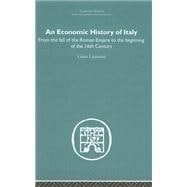
Note: Supplemental materials are not guaranteed with Rental or Used book purchases.
Purchase Benefits
What is included with this book?
| The Last Two Centuries of the Western Empire | p. 1 |
| Structural changes in the Empire during its first 250 years and their economic effects | p. 1 |
| Competition from the provinces | p. 3 |
| Depopulation and disaffection | p. 5 |
| Military and monetary anarchy | p. 6 |
| The reorganization of the Empire by Diocletian and Constantine. Oriental despotism | p. 9 |
| The Germanic invasions and the fall of the western Empire | p. 11 |
| From the Fall of the Western Empire to the Partition of Italy Between Greeks and Lombards | p. 14 |
| Italy under the Ostrogoths | p. 14 |
| The Italian economy during the Gothic Wars and the first years of Byzantine rule | p. 16 |
| The Lombard invasion | p. 17 |
| The partition of Italy between Greeks and Lombards | p. 19 |
| The status of the vanquished Romans. The property of the Church | p. 20 |
| From the Partition of Italy to the Carolingian Conquest (Seventh and Eighth Centuries) | p. 23 |
| Lombard society in Rothari's Edict | p. 23 |
| Signs of revival under the last Lombard kings. Towns and trade in the eighth century | p. 26 |
| Elements of a money economy: trade and trades in Lombard Italy | p. 28 |
| Byzantine Italy in the seventh and eighth centuries. The origins of Venice | p. 31 |
| Economic Conditions in Carolingian and Feudal Italy | p. 36 |
| Lombard Italy under the Carolingians | p. 36 |
| New threats of invasion: Arabs, Hungarians, Slavs, and Normans | p. 38 |
| The feudal system | p. 40 |
| The economic nature of feudalism | p. 42 |
| Beginnings of Revival in the Tenth and Eleventh Centuries | p. 47 |
| The cities of Byzantine Italy: Ravenna, Rome, Bari, Amalfi | p. 47 |
| The rise of Venetian seapower between the ninth and eleventh centuries | p. 51 |
| Pisa and Genoa in the tenth and eleventh centuries | p. 53 |
| The revival of the inland towns | p. 55 |
| The beginnings of change in the countryside | p. 61 |
| Italy in the Eleventh and Twelfth Centuries | p. 66 |
| Social changes after the tenth century and the rise of the urban communes | p. 66 |
| The First Crusade and the maritime towns of Italy | p. 71 |
| The Italian colonies in the Levant | p. 73 |
| The western offensive in the Byzantine East | p. 76 |
| Economic progress in the great inland communes and the development of the bourgeoisie | p. 79 |
| Origin, character, and purpose of the craft and merchant guilds | p. 82 |
| The Urban Economy in Its Prime. The Thirteenth and Fourteenth Centuries | p. 86 |
| The expansion of the greater maritime cities after the Fourth Crusade | p. 86 |
| Economic conditions in the greater communes of inland Italy during the thirteenth and fourteenth centuries | p. 91 |
| Agriculture, industry, and trade in the age of the communes | p. 98 |
| Finance, money, and credit in the age of the communes | p. 121 |
| The Waning of the Middle Ages | p. 137 |
| The changing place of Italy in Europe after 1350 | p. 137 |
| The great sea powers: Genoa and Venice | p. 146 |
| Town and country in Lombardy and Tuscany | p. 155 |
| The predominantly agricultural areas of Italy | p. 161 |
| Bibliographical Note | p. 168 |
| Index | p. 175 |
| Table of Contents provided by Ingram. All Rights Reserved. |
The New copy of this book will include any supplemental materials advertised. Please check the title of the book to determine if it should include any access cards, study guides, lab manuals, CDs, etc.
The Used, Rental and eBook copies of this book are not guaranteed to include any supplemental materials. Typically, only the book itself is included. This is true even if the title states it includes any access cards, study guides, lab manuals, CDs, etc.